We grow the usual garden plants, including a few varieties of tomatoes, hot and sweet peppers, ground cherries, peas, beans, cucumbers, garlic, lettuces, radishes, carrots and many herbs. This year we added into the mix the tomatillo. If it weren’t for the Tomato Family, we would have a garden half as big. The tomatoes, peppers, ground cherries and tomatillos are all members of this family.
We plant seedlings or seeds for many of the vegetables that we want to grow. In addition to planting known veggies, we allow certain ones that re-seed themselves to come up again. Lettuces, cherry tomatoes, and ground cherries are the common re-seeders. The only problem with this method is that the garden can quickly become overgrown if the volunteers are not thinned out vigorously. We learned that last year.
This year a new problem cropped up. A weedy plant was left to grow in the vegetable garden presumably because of its mistaken identity. We’re pretty good at pulling weeds and mulching to keep the weeds from overtaking the garden, but somehow this one weed was left to grow too big.
It turns out that the leaves of this alien plant look a lot like the leaves of the ground cherry. It was hiding under a cherry tomato, and when that was staked up the odd plant was finally noticed. Once detected, it was left to grow a while just for observation. It was pulled out before the fruit was dropped, so hopefully next year we won’t have a garden full.
The alien plant in question was the deadly Common Nightshade, Solanum nigrum. It’s a member of the Tomato family or the Nightshade family, Solanaceae. Other family members include plants that give edible fruits, such as the tomato, potato, ground cherry, bell pepper, chili pepper and eggplant. Tobacco is another useful family member.
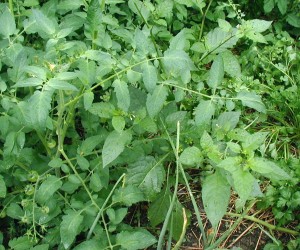
Being in the tomato family suggests some similarity between these plants. Common Solanum characteristics include the flower shape with five petals that are often reflexed backwards, yellow stamens that form a beak around the central pistil, and somewhat triangular-shaped leaves.
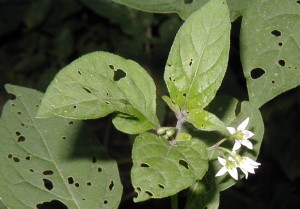
Tomatoes, ground cherries and tomatillos are similar to the common nightshade. It seemed a little odd that the nightshade leaves were full of holes whereas the others were not. Of course they all had insect damage, but the small roundish holes in the nightshade leaves weren’t seen as much in the other tomato relatives.
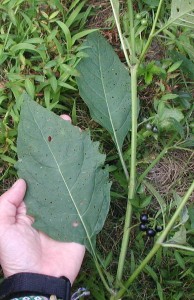
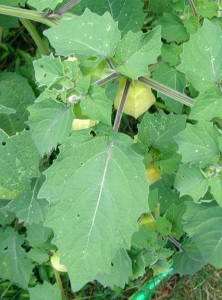
Common places to find this nightshade are disturbed areas, waste ground and cultivated grounds, such as found in the vegetable garden. We probably have birds to thank for dropping seeds wherever they go.
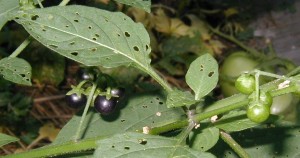
DO NOT INGEST NIGHTSHADE BERRIES OR ANY PLANT PART! A chemical called solanine is found in all parts of the plant and it is toxic. See comments below.
Please read the article by Samuel Thayer on black nightshade. It is available on the Internet, and can be found on his website, foragersharvest.com. He says the toxin, solamine, is not present in the ripened berry of black nightshade. I am most interested in receiving a reply from you after you have read his article. Please let me know what you think, as the two of you (at the time you wrote this article) have opposing beliefs about the fruit of black nightshade. Did his article change your mind? If not, why not?
Thankyou in advance for any consideration you are willing to give this matter.
Sincerely, Dean Graves (deangraves1@yahoo.com)
Hey Dean,
I remember being shown by my mother that the black nightshade berries were not to be eaten. And, always, the word nightshade seemed to be preceded by deadly. I guess that’s the safe way to instruct the curious child, go for safety.
However, I can’t argue with the guy who’s written the book on foraging for food as Samuel Thayer has also been inducted into the National Wild Foods Hall of Fame. Who knew?
Thanks for letting me in on the secret. I did read his article on black nightshade and learned that the black berries are supposed to be delicious and non-toxic. (To that end I’ve removed my cautionary statement at the end of this post on eating this plant.)
That’s contrary to what I was lead to believe as a child and as an adult reading Peterson’s Guide on Edible Wild Plants. A skull and crossbones and the word POISONOUS marks the entry of Common Nightshade where it’s stated, “Warning: Although there is some controversy as to the edibility of the fully ripe berries, they should be left alone. The green berries contain solanine and can be fatal if eaten in sufficient quantity.”
The word fatal is kind of strong there, so I’m still hesitant to try eating a berry. If Samuel ate some in front of me and he was ok in a few days, then I’d try it for sure!
My mom ate these found in fields when she was a kid. I have been eating them since I was little. Just the black ones are edible.
Cool Mike! It is a good thing to remember only the black ones. Thanks!
My mum also ate these and us children ate them frequently but not a lot at one time when we were growing up. Anyone that ever saw us eating them shreaked out saying they were poisonious.
LOL, Tamara! The way you put it that people shreaked! How funny. I guess they didn’t do y’all any harm, huh? The poison is in the dose so you must not have had too much. Good on ya.
Do you remember what they tasted like? Sweet, sour?
There are plenty of plants that have no threat of death whatsoever hanging over them. Nightshade is a completely and utterly unnecessary and possibly lethal risk. Until a resounding and embarrassingly obvious chorus of innumerable and redundant experts genuinely clearS them as safe, DO NOT EAT NIGHTSHADE BERRIES OF ANY COLOR.
It is a controversial issue, Abraham. I’m with you though, take caution people! Don’t go around eating berries that you’re not POSITIVE of their identification. All commenters on here make note of eating fully ripe berries, which would be the totally black ones. I’m still sticking to the known plants in my garden, well-known wild ones like blackberries and black raspberries, and the occasional odd wild berry of false solomon’s seal or Bastard Toadflax nutlets.
Would nightshade roots affect grapevine roots at all?
Hey Barb, that’s a good question. I have no idea.
Sorry I can’t help ya figure that one out.
So I’ve ran across the same issue. Did you ever find a way to distinguish between the two plants (common nightshade and ground cherry) while they are still young? I have a bunch of volunteers and would like to clean up my garden earlier than later (putting on fruit).
Hi Travis!
Do you see a color difference in the leaves or the shape of the base of the leaves? It seems like ground cheery has more of a heart-shaped leaf base and the nightshades are often a darker green.
Curious to hear of your observations! Otherwise, I’m not much help in deciphering the two. You might have to wait until the flowers start appearing to know for sure.
Good luck and let us know what you find out.
Wilde,
Thanks. Up to this point mine have shown the darker leaves and the holes like you listed for the common nightshade. Just in the last few days though, they have put on the yellow blossoms for which I’m familiar with as the tomatillo. Guess I still have more to learn. Thanks again!
Thanks for sharing your observations, Travis.
I think identifying young plants is very hard to get right. Indeed, all the identification and guide books have us looking at mature flowering plants!
I was fortunate to find a couple of ground cherry plants at a local nursery and planted them in large pots. They’re getting bigger having flowered and with small green fruit already. Looking forward to tasting them in a couple weeks!
I can testify that Solanum nigrum is edible leaves and all. It is routinely cooked in India and I grew up eating them. My son and I are now eating the berries in the U.S. We are still alive. If I get around to it, I would cook the leaves too. What some are confused with is the Deadly nightshade, a different plant in the family. So, learn to ID. 😀
Thank you for your comment, Deepa. The problem like you said is to properly ID the plant in question.
When in doubt, do not eat it!
We have the same problem in our building vegetable patch… the cherry tomato in question here are something I planted within few days I saw this one too… both caught disease but after some care the disease vanished and both bushes are big now… both flowering and the green fruits of the nightshade are out… I’ve now asked the maintenance guy who started this vegetable patch to remove the nightshade and May be plant somewhere else… hopefully he finds time to do it. My main question is is it save to consume the cherry tomatoes that’s growing with it? I hope it’s alright?
Oh yeah, Poojitha! I say go for it. The cherry tomatoes are safe to consume even when growing next to the nightshade. Any of the toxic compounds from nightshade are held in the plant so it’s not going to contaminate the surrounding soil or nearby plants.
Enjoy! Do you eat the tomatoes raw or how do you cook them?